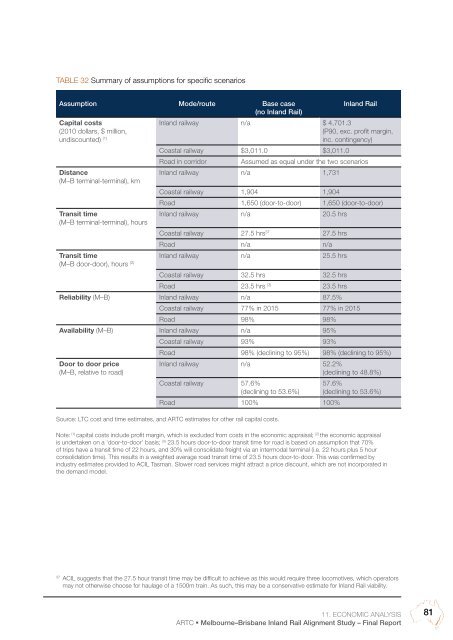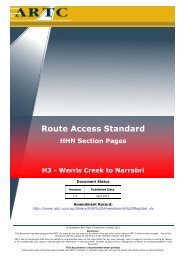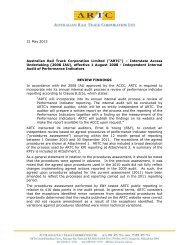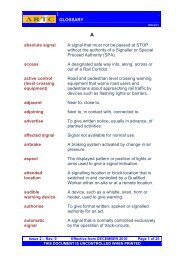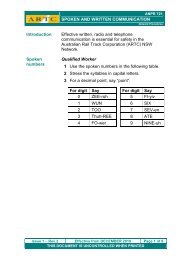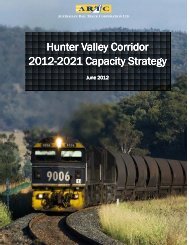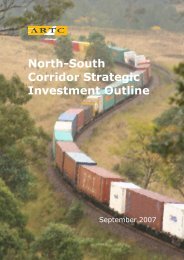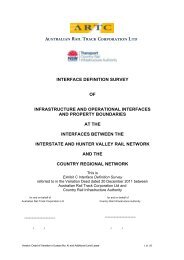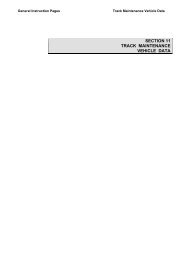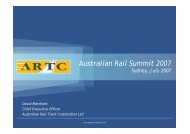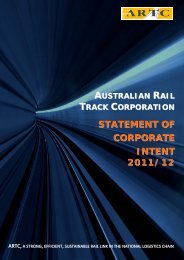MelbourneâBrisbane Inland Rail Alignment Study - Australian Rail ...
MelbourneâBrisbane Inland Rail Alignment Study - Australian Rail ...
MelbourneâBrisbane Inland Rail Alignment Study - Australian Rail ...
You also want an ePaper? Increase the reach of your titles
YUMPU automatically turns print PDFs into web optimized ePapers that Google loves.
Table 32 Summary of assumptions for specific scenarios<br />
<strong>Inland</strong> n/a $<br />
Assumption Mode/route Base case<br />
<strong>Inland</strong> <strong>Rail</strong><br />
(no <strong>Inland</strong> <strong>Rail</strong>)<br />
Capital costs<br />
railway 4,701.3<br />
undiscounted) (1) inc. contingency)<br />
(2010 dollars, $ million,<br />
(P90, exc. profit margin,<br />
Coastal railway $3,011.0 $3,011.0<br />
Road in corridor Assumed as equal under the two scenarios<br />
Distance<br />
<strong>Inland</strong> railway n/a 1,731<br />
(M–B terminal-terminal), km<br />
Coastal railway 1,904 1,904<br />
Road 1,650 (door-to-door) 1,650 (door-to-door)<br />
Transit time<br />
<strong>Inland</strong> railway n/a 20.5 hrs<br />
(M–B terminal-terminal), hours<br />
Coastal railway 27.5 hrs 37 27.5 hrs<br />
Road n/a n/a<br />
Transit time<br />
<strong>Inland</strong> railway n/a 25.5 hrs<br />
(M–B door-door), hours (2) Coastal railway 32.5 hrs 32.5 hrs<br />
Road 23.5 hrs (3) 23.5 hrs<br />
Reliability (M–B) <strong>Inland</strong> railway n/a 87.5%<br />
Coastal railway 77% in 2015 77% in 2015<br />
Road 98% 98%<br />
Availability (M–B) <strong>Inland</strong> railway n/a 95%<br />
Coastal railway 93% 93%<br />
Road 98% (declining to 95%) 98% (declining to 95%)<br />
Door to door price<br />
(M–B, relative to road)<br />
<strong>Inland</strong> railway n/a 52.2%<br />
(declining to 48.8%)<br />
Coastal railway 57.6%<br />
(declining to 53.6%)<br />
Road 100% 100%<br />
Source: LTC cost and time estimates, and ARTC estimates for other rail capital costs.<br />
57.6%<br />
(declining to 53.6%)<br />
Note: (1) capital costs include profit margin, which is excluded from costs in the economic appraisal; (2) the economic appraisal<br />
is undertaken on a ‘door-to-door’ basis; (3) 23.5 hours door-to-door transit time for road is based on assumption that 70%<br />
of trips have a transit time of 22 hours, and 30% will consolidate freight via an intermodal terminal (i.e. 22 hours plus 5 hour<br />
consolidation time). This results in a weighted average road transit time of 23.5 hours door-to-door. This was confirmed by<br />
industry estimates provided to ACIL Tasman. Slower road services might attract a price discount, which are not incorporated in<br />
the demand model.<br />
37<br />
ACIL suggests that the 27.5 hour transit time may be difficult to achieve as this would require three locomotives, which operators<br />
may not otherwise choose for haulage of a 1500m train. As such, this may be a conservative estimate for <strong>Inland</strong> <strong>Rail</strong> viability.<br />
11. Economic analysis<br />
ARTC • Melbourne–Brisbane <strong>Inland</strong> <strong>Rail</strong> <strong>Alignment</strong> <strong>Study</strong> – Final Report<br />
81


